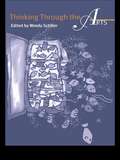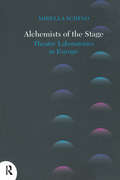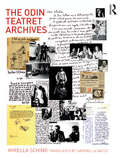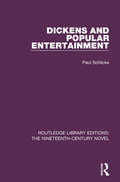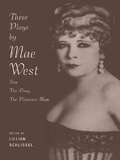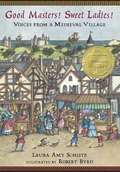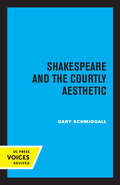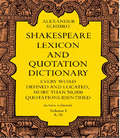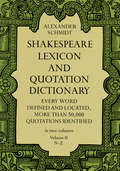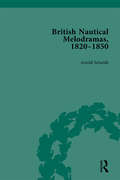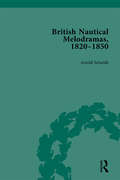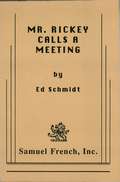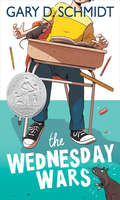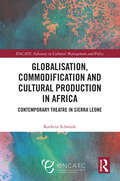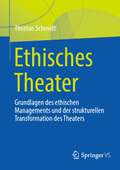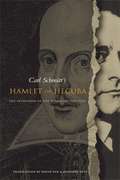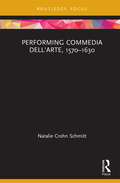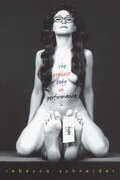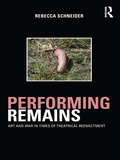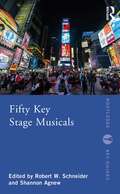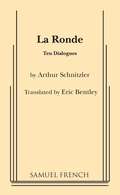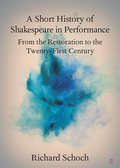- Table View
- List View
Thinking Through the Arts
by Wendy SchillerThinking Through the Arts draws together a number of different approaches to teaching young children that combine the experience of thinking with the act of expression through art. Developed as an inclusive, broad-ranging and user-friendly text, Thinking Through the Arts presents the unique insight of teachers as researchers, and counters the view that art is emotionally-based and therefore irrelevant to thinking and learning. The areas covered include drama, dance, music, arts environments, technologies, museums and galleries, literacy, cognition, international influences, curriculum development, research and practice. Early childhood and primary teachers and students alike will find this book is an invaluable source of new insights for their own teaching.
Alchemists of the Stage: Theatre Laboratories in Europe (Routledge Icarus Ser.)
by Mirella SchinoWhat is a theatre laboratory? Why a theatre laboratory? This book tries to answer these questions focusing on the experiences and theories, the visions and the techniques, the differences and similarities of European theatre laboratories in the twentieth century. It studies in depth the Studios of Stanislavski and Meyerhold, the school of Decroux, the Teatr Laboratorium of Jerzy Grotowski and Ludwik Flaszen, as well as Eugenio Barba's Odin Teatret. Theatre laboratories embody a theatre practice which defies the demands and fashions of the times, the usual ways of production and the sensible functions which stage art enjoys in our society. It is a theatre which refuses to be only art and whose radical research forges new conditions with a view to changing both the actor and the spectator. This research transforms theatrical craft into a laboratory which has been compared to the laboratory of the alchemists, who worked not on material but on substance. The alchemists of the stage did not operate only on forms and styles, but mainly on the living matter of the theatre: the actor, seen not just as an artist but above all as a representative of a new human being. Laboratory theatres have rarely been at the centre of the news. Yet their underground activity has influenced theatre history. Without them, the same idea of theatre, as it has been shaped in the course of the twentieth century, would have been different. In this book Mirella Schino recounts, as in a novel, the vicissitudes of a group of practitioners and scholars who try to uncover the technical, political and spiritual perspectives behind the word laboratory when applied to the theatre.
The Odin Teatret Archives
by Mirella SchinoThe Odin Teatret Archives presents collections from the archives of one of the foremost reference points in global theatre. Letters, notes, work diaries, articles, and a wealth of photographs all chart the daily activity that underpins the life of Odin Teatret, telling the adventurous, complex stories which have produced the pioneering work that defines Odin's laboratory approach to theatre. Odin Teatret have been at the forefront of theatrical innovation for over fifty years, devising new strategies for actor training, knowledge sharing, performance making, theatrical alliances, and ways of creating and encountering audiences. Their extraordinary work has pushed boundaries between Western and Eastern theatre; between process and performance; and between different theatre networks across the world. In this unique volume, Mirella Schino brings together a never before seen collection of source materials which reveal the social, political, and artistic questions facing not just one groundbreaking company, but everyone who tries to make a life in the theatre.
Dickens and Popular Entertainment (Routledge Library Editions: The Nineteenth-Century Novel #34)
by Paul SchlickeFirst published in 1985. Dickens was a vigorous champion of the right of all men and women to carefree amusements and dedicated himself to the creation of imaginative pleasure. This book represents the first extended study of this vital aspect of Dickens’ life and work, exploring how he channelled his love of entertainment into his artistry. This study offers a challenging reassessment of Nicholas Nickleby, The Old Curiosity Shop and Hard Times. It shows the importance of entertainment to Dickens’ journalism and presents an illuminating perspective on the public readings which dominated the last twelve years of his life. This book will be of interest to students of literature.
Three Plays by Mae West: Sex, The Drag and Pleasure Man
by Lillian SchlisseMae West, wise-cracking vaudeville performer, was one of the most controversial figures of her era. Rarely, however, do people think of Mae West as a writer. In Three Plays By Mae West, Lillian Schlissel brings this underexplored part of West's career to the fore by offering for the first time in book form, three of the plays West wrote in the 1920s--Sex (1926), The Drag (1927) and Pleasure Man (1928). With an insightful introduction by Schlissel, this book offers a unique look into to the life and early career of this legendary stage and screen actress.
Good Masters! Sweet Ladies! Voices From a Medieval Village
by Laura Ann SchlitzStep back to an English village in 1255, where life plays out in dramatic vignettes illuminating twenty-two unforgettable characters.<P><P> Maidens, monks, and millers’ sons — in these pages, readers will meet them all. There’s Hugo, the lord’s nephew, forced to prove his manhood by hunting a wild boar; sharp-tongued Nelly, who supports her family by selling live eels; and the peasant’s daughter, Mogg, who gets a clever lesson in how to save a cow from a greedy landlord. There’s also mud-slinging Barbary (and her noble victim); Jack, the compassionate half-wit; Alice, the singing shepherdess; and many more. With a deep appreciation for the period and a grand affection for both characters and audience, Laura Amy Schlitz creates twenty-two riveting portraits and linguistic gems equally suited to silent reading or performance. Illustrated with pen-and-ink drawings by Robert Byrd — inspired by the Munich-Nuremberg manuscript, an illuminated poem from thirteenth-century Germany — this witty, historically accurate, and utterly human collection forms an exquisite bridge to the people and places of medieval England.<P> A Newbery Award book.
Shakespeare and the Courtly Aesthetic
by Gary R. SchmidgallThis title is part of UC Press's Voices Revived program, which commemorates University of California Press’s mission to seek out and cultivate the brightest minds and give them voice, reach, and impact. Drawing on a backlist dating to 1893, Voices Revived makes high-quality, peer-reviewed scholarship accessible once again using print-on-demand technology. This title was originally published in 1981.
Shakespeare Lexicon and Quotation Dictionary: A Complete Dictionary Of All The English Words, Phrases, And Constructions In The Works Of The Poet (Third Edition)
by Alexander SchmidtIn more than 300 years of Shakespearean scholarship, only one book, the famous Shakespeare Lexicon and Quotation Dictionary, has investigated the meaning of every word that Shakespeare wrote. The lifetime work of Professor Alexander Schmidt of Königsberg, this book has long been the indispensable companion for every person seriously interested in Shakespeare, Renaissance poetry and prose of any sort, or English literature. It is really two important books in one. <p><p> Schmidt’s set contains every single word that Shakespeare used, not simply words that have changed their meaning since the seventeenth century, but every word in all the accepted plays and the poems. Covering both quartos and folios, it carefully distinguishes between shades of meaning for each word and provides exact definitions, plus governing phrases and locations, down to the numbered line of the Cambridge edition of Shakespeare. There is no other word dictionary comparable to this work. <p> Even more useful to the general reader, however, is the incredible wealth of exact quotations. Arranged under the words of the quotation itself (hence no need to consult confusing subject classifications) are more than 50,000 exact quotations. Each is precisely located, so that you can easily refer back to the plays or poems themselves, if you wish context.Other features helpful to the scholar are appendixes on basic grammatical observations, a glossary of provincialisms, a list of words and sentences taken from foreign languages, a list of words that form the latter part of word-combinations. This third edition features a supplement with new findings.
Shakespeare Lexicon and Quotation Dictionary (Third Edition)
by Alexander SchmidtIn more than 300 years of Shakespearean scholarship, only one book, the famous Shakespeare Lexicon and Quotation Dictionary, has investigated the meaning of every word that Shakespeare wrote. The lifetime work of Professor Alexander Schmidt of Königsberg, this book has long been the indispensable companion for every person seriously interested in Shakespeare, Renaissance poetry and prose of any sort, or English literature. It is really two important books in one. <p><p> Schmidt’s set contains every single word that Shakespeare used, not simply words that have changed their meaning since the seventeenth century, but every word in all the accepted plays and the poems. Covering both quartos and folios, it carefully distinguishes between shades of meaning for each word and provides exact definitions, plus governing phrases and locations, down to the numbered line of the Cambridge edition of Shakespeare. There is no other word dictionary comparable to this work. <p> Even more useful to the general reader, however, is the incredible wealth of exact quotations. Arranged under the words of the quotation itself (hence no need to consult confusing subject classifications) are more than 50,000 exact quotations. Each is precisely located, so that you can easily refer back to the plays or poems themselves, if you wish context.Other features helpful to the scholar are appendixes on basic grammatical observations, a glossary of provincialisms, a list of words and sentences taken from foreign languages, a list of words that form the latter part of word-combinations. This third edition features a supplement with new findings.
British Nautical Melodramas, 1820–1850: Volume III
by Arnold SchmidtDuring the 1820s and 30s nautical melodramas "reigned supreme" on London stages, entertaining the mariners and maritime workers who comprised a large part of the audience for small theatres with the same sentimental moments and comic interludes of domestic melodrama mixed with patriotic images that communicated and reinforced imperial themes. However, generally the study of British theatre history moves from medieval and renaissance plays directly to the realism and naturalism of late Victorian and modern drama. Readers typically encounter a gap between Restoration and eighteenth-century plays like those of Oliver Goldsmith and Richard Brinsley Sheridan, and late-nineteenth plays by Henrik Ibsen and Oscar Wilde. Nineteenth-century drama, with the possible exception of plays by Byron, Shelley, and Wordsworth, remains all but invisible. Until recently, melodramatic plays written and performed during this "gap" received little scholarly attention, but their value as reflections of Britain’s promulgation of imperial ideology — and its role in constructing and maintaining class, gender, and racial identities — have given discussions of melodrama force and momentum. The plays in included in these three volumes have never appeared in a critical anthology and most have not been republished since their original nineteenth-century editions. Each play is transcribed from the original documents and includes an author biography, a headnote about the play itself, full annotations with brief definitions of unfamiliar vocabulary, and explanatory notes. Comprehensive editorial apparatus details the nineteenth-century imperial, naval, political, and social history relevant to the plays’ nautical themes, as well as discussing nineteenth-century theatre history, melodrama generally, and the nautical melodrama in particular. Contemporary theatre practices — acting, audiences, staging, lighting, special effects — are also examined. An extensive bibliography of primary and secondary texts; a complete index; and contemporary images of the actors, theatres, stage sets, playbills, costumes, and locales have been compiled to aid study further. The appendices include maps of Britain, Europe, and the East and West Indies.
British Nautical Melodramas, 1820–1850: Volume II
by Arnold SchmidtDuring the 1820s and 30s nautical melodramas "reigned supreme" on London stages, entertaining the mariners and maritime workers who comprised a large part of the audience for small theatres with the same sentimental moments and comic interludes of domestic melodrama mixed with patriotic images that communicated and reinforced imperial themes. However, generally the study of British theatre history moves from medieval and renaissance plays directly to the realism and naturalism of late Victorian and modern drama. Readers typically encounter a gap between Restoration and eighteenth-century plays like those of Oliver Goldsmith and Richard Brinsley Sheridan, and late-nineteenth plays by Henrik Ibsen and Oscar Wilde. Nineteenth-century drama, with the possible exception of plays by Byron, Shelley, and Wordsworth, remains all but invisible. Until recently, melodramatic plays written and performed during this "gap" received little scholarly attention, but their value as reflections of Britain’s promulgation of imperial ideology — and its role in constructing and maintaining class, gender, and racial identities — have given discussions of melodrama force and momentum. The plays in included in these three volumes have never appeared in a critical anthology and most have not been republished since their original nineteenth-century editions. Each play is transcribed from the original documents and includes an author biography, a headnote about the play itself, full annotations with brief definitions of unfamiliar vocabulary, and explanatory notes. Comprehensive editorial apparatus details the nineteenth-century imperial, naval, political, and social history relevant to the plays’ nautical themes, as well as discussing nineteenth-century theatre history, melodrama generally, and the nautical melodrama in particular. Contemporary theatre practices — acting, audiences, staging, lighting, special effects — are also examined. An extensive bibliography of primary and secondary texts; a complete index; and contemporary images of the actors, theatres, stage sets, playbills, costumes, and locales have been compiled to aid study further. The appendices include maps of Britain, Europe, and the East and West Indies.
British Nautical Melodramas, 1820–1850: Volume I
by Arnold SchmidtDuring the 1820s and 30s nautical melodramas "reigned supreme" on London stages, entertaining the mariners and maritime workers who comprised a large part of the audience for small theatres with the same sentimental moments and comic interludes of domestic melodrama mixed with patriotic images that communicated and reinforced imperial themes. However, generally the study of British theatre history moves from medieval and renaissance plays directly to the realism and naturalism of late Victorian and modern drama. Readers typically encounter a gap between Restoration and eighteenth-century plays like those of Oliver Goldsmith and Richard Brinsley Sheridan, and late-nineteenth plays by Henrik Ibsen and Oscar Wilde. Nineteenth-century drama, with the possible exception of plays by Byron, Shelley, and Wordsworth, remains all but invisible. Until recently, melodramatic plays written and performed during this "gap" received little scholarly attention, but their value as reflections of Britain’s promulgation of imperial ideology — and its role in constructing and maintaining class, gender, and racial identities — have given discussions of melodrama force and momentum. The plays in included in these three volumes have never appeared in a critical anthology and most have not been republished since their original nineteenth-century editions. Each play is transcribed from the original documents and includes an author biography, a headnote about the play itself, full annotations with brief definitions of unfamiliar vocabulary, and explanatory notes. Comprehensive editorial apparatus details the nineteenth-century imperial, naval, political, and social history relevant to the plays’ nautical themes, as well as discussing nineteenth-century theatre history, melodrama generally, and the nautical melodrama in particular. Contemporary theatre practices — acting, audiences, staging, lighting, special effects — are also examined. An extensive bibliography of primary and secondary texts; a complete index; and contemporary images of the actors, theatres, stage sets, playbills, costumes, and locales have been compiled to aid study further. The appendices include maps of Britain, Europe, and the East and West Indies.
Mr. Rickey Calls a Meeting
by Ed SchmidtDrama / 6m / Interior / Joe Louis, Paul Robeson, Bill "Bojangles" Robinson, Jackie Robinson, and Brooklyn Dodgers owner Branch Rickey meet in 1947 to discuss a strategy for dropping a baseball bombshell: promoting a black to the major leagues. That is the premise of this brilliant and timely play. Issues raised include compensation for the possible demise of the Negro leagues and the advisability of one at a time integration. If you want freedom of opportunity, do you play by the white's rules or do you demand that he play by yours?
The Wednesday Wars
by Gary D. SchmidtIn this Newbery Honor-winning novel, Gary D. Schmidt offers an unforgettable antihero. The Wednesday Wars is a wonderfully witty and compelling story about a teenage boy’s mishaps and adventures over the course of the 1967–68 school year in Long Island, New York.<P><P> Meet Holling Hoodhood, a seventh-grader at Camillo Junior High, who must spend Wednesday afternoons with his teacher, Mrs. Baker, while the rest of the class has religious instruction. Mrs. Baker doesn’t like Holling—he’s sure of it. Why else would she make him read the plays of William Shakespeare outside class? But everyone has bigger things to worry about, like Vietnam. His father wants Holling and his sister to be on their best behavior: the success of his business depends on it. But how can Holling stay out of trouble when he has so much to contend with? A bully demanding cream puffs; angry rats; and a baseball hero signing autographs the very same night Holling has to appear in a play in yellow tights! As fate sneaks up on him again and again, Holling finds Motivation—the Big M—in the most unexpected places and musters up the courage to embrace his destiny, in spite of himself.
Globalisation, Commodification and Cultural Production in Africa: Contemporary Theatre in Sierra Leone (ENCATC Advances in Cultural Management and Policy)
by Kathrin SchmidtThis book engages with contemporary cultural production in Africa, focusing on theatre in Sierra Leone as main case study. The author provides coverage of, and insights into, such themes as cultural globalisation, commodification, the global creative economy, culture and development, international relations and contemporary cultural production in Sierra Leone within the context of local and global flows of people, media, images, technologies, finance and ideas. Combining the analysis of theatre in Sierra Leone and its aesthetics with its policy, structural and institutional context, this book highlights in much detail and nuance the interconnectedness between the micro- and the macro-levels of cultural production, between the local and the global, and between aesthetics, politics, policy, governance structures and institutions. This book links the particular findings from the author’s fieldwork to larger issues of contemporary local cultural production within the context of globalisation, commodification and decolonisation; adds a postcolonial perspective to existing theories and approaches to cultural production, management and policy, which is still largely missing from the existing discourse; and also contributes to addressing the gap in the knowledge about the context of contemporary cultural productions in diverse African contexts. This book will be particularly useful for both theatre scholars with an interest in the political economy of theatre and, more broadly, those seeking to understand the nuanced challenges and opportunities faced by policymakers, artists and arts managers to embrace the cultural and creative industries in this context. It also offers excellent insights for policymakers who wish to improve their understanding and interventions beyond superficial ‘best practice’ snippets and simplified ‘success stories’.
Ethisches Theater: Grundlagen des ethischen Managements und der strukturellen Transformation des Theaters
by Thomas SchmidtMit dem Konzept des Ethischen Theaters wird ein ganzheitliches Zukunftsmodell vorgestellt. Ausgangspunkt ist die Analyse der gegenwärtigen Krisen und der Komplexität in den deutschsprachigen Theatern, um die Grundlagen für ihren Transformationsprozess zu entwickeln. Mit dem Ethischen Theater wird ein Ziel dieses Prozesses vorgestellt: das ganzheitliches Zukunftsmodell einer Theater-Organisation des 21. Jahrhunderts, in der ethische Überlegungen erstmals in allen Prozessen handlungsleitend sind. Das Modell ist kompatibel mit den Interessen der Stakeholder und den wichtigen Reformprozessen, es ermöglicht die anstehende strukturelle Modernisierung der Theaterbetriebe. Unterstützt wird es durch das Konzept des Ethischen Theatermanagements, das erstmals über die klassischen Funktionen hinaus auch Aspekte der Diversität, der Nachhaltigkeit, der Ethik und der Zukunftsfähigkeit adressiert. Mit den erweiterten Funktionen des ethischen Managements werden auch weitere Möglichkeitsräume für die Zukunft der Kultur-Organisationen eröffnet.
Hamlet or Hecuba: The Intrusion of the Time into the Play
by Carl Schmitt David Pan Jennifer R. RustHamlet or Hecuba by Carl Schmitt provides an innovative and insightful analysis of Shakespeare's tragedy in terms of the historical situation of its creation.
Befriending the Commedia dell'Arte of Flaminio Scala
by Natalie Crohn SchmittThe most important theatrical movement in sixteenth- and early seventeenth-century Europe, the commedia dell'arte has inspired playwrights, artists, and musicians including Molière, Dario Fo, Picasso, and Stravinsky. Because of its stock characters, improvised dialogue, and extravagant theatricalism, the commedia dell'arte is often assumed to be a superficial comic style. With Befriending the Commedia dell'Arte of Flaminio Scala, Natalie Crohn Schmitt demolishes that assumption.By reconstructing the commedia dell'arte scenarios published by troupe manager Flaminio Scala (1547-1624), Schmitt demonstrates that in its Golden Age the commedia dell'arte relied as much on craftsmanship as on improvisation and that Scala's scenarios are a treasure trove of social commentary on early modern daily life in Italy.In the book, Schmitt makes use of her intensive research into the social and cultural history of sixteenth-century Italy and the aesthetic principles of the period. She combines this research with her insights drawn from studying with contemporary commedia dell'arte performers and from directing a production of one of Scala's scenarios. The result is a new perspective on the commedia dell'arte that illuminates the style's full richness.
Performing Commedia dell'Arte, 1570-1630
by Natalie Crohn SchmittPerforming Commedia dell’Arte, 1570-1630 explores the performance techniques employed in commedia dell’arte and the ways in which they served to rapidly spread the ideas that were to form the basis of modern theatre throughout Europe. Chapters include one on why, what, and how actors improvised, one on acting styles, including dialects, voice and gesture; and one on masks and their uses and importance. These chapters on historical performance are followed by a coda on commedia dell’arte today. Together they offer readers a look at both past and present iterations of these performances. Suitable for both scholars and performers, Performing Commedia dell’Arte, 1570-1630 bears on essential questions about the techniques of performance and their utility for this important theatrical form.
The Explicit Body in Performance
by Rebecca SchneiderThe Explicit Body in Performance interrogates the avant-garde precedents and theoretical terrain that combined to produce feminist performance art. Among the many artists discussed are: * Carolle Schneemann * Annie Sprinkle * Karen Finley * Robbie McCauley * Ana Mendieta * Ann Magnuson * Sandra Bernhard * Spiderwoman Rebecca Schneider tackles topics ranging across the 'post-porn modernist movement', New Right censorship, commodity fetishism, perspectival vision, and primitivism. Employing diverse critical theories from Benjamin to Lacan to postcolonial and queer theory, Schneider analyses artistic and pop cultural depictions of the explicit body in late commodity capitalism. The Explicit Body in Performance is complemented by extensive photographic illustrations and artistic productions of postmodern feminist practitioners. The book is a fascinating exploration of how these artists have wrestled with the representational structures of desire.
Performing Remains: Art and War in Times of Theatrical Reenactment
by Rebecca Schneider'At last, the past has arrived! Performing Remains is Rebecca Schneider's authoritative statement on a major topic of interest to the field of theatre and performance studies. It extends and consolidates her pioneering contributions to the field through its interdisciplinary method, vivid writing, and stimulating polemic. Performing Remains has been eagerly awaited, and will be appreciated now and in the future for its rigorous investigations into the aesthetic and political potential of reenactments.' - Tavia Nyong'o, Tisch School of the Arts, New York University 'I have often wondered where the big, important, paradigm-changing book about re-enactment is: Schneider’s book seems to me to be that book. Her work is challenging, thoughtful and innovative and will set the agenda for study in a number of areas for the next decade.' - Jerome de Groot, University of Manchester Performing Remains is a dazzling new study exploring the role of the fake, the false and the faux in contemporary performance. Rebecca Schneider argues passionately that performance can be engaged as what remains, rather than what disappears. Across seven essays, Schneider presents a forensic and unique examination of both contemporary and historical performance, drawing on a variety of elucidating sources including the "America" plays of Linda Mussmann and Suzan-Lori Parks, performances of Marina Abramovic´ and Allison Smith, and the continued popular appeal of Civil War reenactments. Performing Remains questions the importance of representation throughout history and today, while boldly reassessing the ritual value of failure to recapture the past and recreate the "original."
Fifty Key Stage Musicals (Routledge Key Guides)
by Robert W. SchneiderThis volume in the Routledge Key Guides series provides a round-up of the fifty musicals whose creations were seminal in altering the landscape of musical theater discourse in the English-speaking world. Each entry summarises a show, including a full synopsis, discussion of the creators' process, show's critical reception, and its impact on the landscape of musical theater. This is the ideal primer for students of musical theater – its performance, history, and place in the modern theatrical world – as well as fans and lovers of musicals.
La Ronde
by Arthur SchnitzlerArthur Schnitzler, Translated by Eric Bentley Full Length, ComedyCharacters: 5 male, 5 female. By the author of the classic romantic romp The Loves of Anatol, Schnitzler's popular roundelay of love in old Vienna is told in ten interwoven scenes: two characters appear in each and one of these moves into the next. The soldier of the first scene leaves a prostitute to appear in the next scene with a parlor maid. The maid then departs to be with her wealthy employer. He, in turn, receives his mistress, a certain married lady. The next scene is reveals the married lady and her husband and then the husband meets a street girl at a private cafe. This girl and her poet lover, the poet and the actress, the actress and the count, and finally the count and the prostitute bring the evening full circle.
A Short History of Shakespeare in Performance: From the Restoration to the Twenty-First Century (Elements in Shakespeare Performance)
by Richard SchochWriting the History of the British Stage, 1660–1900
by Richard SchochThis is the first book on British theatre historiography. It traces the practice of theatre history from its origins in the Restoration to its emergence as an academic discipline in the early twentieth century. In this compelling revisionist study, Richard Schoch reclaims the deep history of British theatre history, valorizing the usually overlooked scholarship undertaken by antiquarians, booksellers, bibliographers, journalists and theatrical insiders, none of whom considered themselves to be professional historians. Drawing together deep archival research, close readings of historical texts from the seventeenth, eighteenth and nineteenth centuries, and an awareness of contemporary debates about disciplinary practice, Schoch overturns received interpretations of British theatre historiography and shows that the practice - and the diverse practitioners - of theatre history were far more complicated and far more sophisticated than we had realised. His book is a landmark contribution to how theatre historians today can understand their own history.
